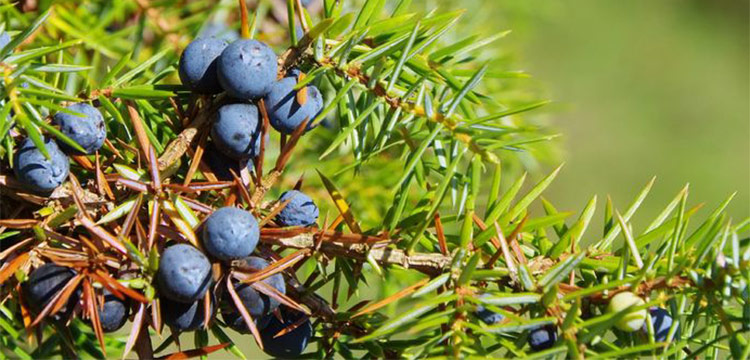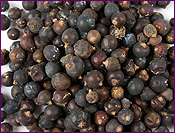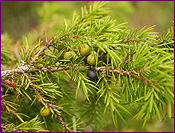Juniper Berry Essential Oil
Juniperus communis

Description
The branches and berries of the Juniper, a coniferous tree, have been used for medicinal and spiritual purposes since ancient times.

The Old Testament includes several references to the juniper tree including Psalms 120:4. This verse references burning a person with a false, deceitful tongue with the coals (perhaps burning branches/logs?) of the broom tree, an ancient name for a variety of juniper shrub that grows in Palestine. This passage can be looked at in several ways, one being that the juniper was used to cleanse, purify and eliminate that which is false and negative.

Native Americans use juniper berries for medicinal applications and burn the berries to cleanse and purify the air. I dabble in making natural forms of incense and include juniper berries and Juniper Berry Essential Oil in several of my personal recipes. Some involved in energy work and crystal healing use Juniper Berry Essential Oil to cleanse and clear crystals (however, be careful as some crystals are extremely fragile or porous, and undiluted Juniper Berry Essential Oil could possibly damage them).
Juniper berries are a natural antiseptic, as is the essential oil. It may help combat acne when used at low dilutions in skin care applications. A room mist/air freshener made with Juniper Berry Essential Oil may help to kill airborne germs.
Emotionally, Juniper Berry Essential Oil is calming and helps to ease stress without imparting the sedative effects that clary sage and the chamomiles are known for. Spiritually, Juniper Berry Essential Oil used in a room mist, diffuser or candle burner cleanses and purifies the air. It is a good choice for use during prayer or meditation. I prefer to use Juniper Berry Essential Oil in a candle diffuser instead of a nebulizer.

Juniper Oil has a distinctive aroma that is woody, sweet, fresh and crisp. Juniper Berry Essential Oil blends well with wood oils like cedarwood, sandalwood and rosewood and other conifers like cypress and fir needle. I also enjoy it blended with clary sage, or the grounding base notes of vetiver or patchouli. I also enjoy juniper berry blended with citrus oils including sweet orange or grapefruit.
Juniper berries are responsible for giving gin its distinctive flavor. The name gin is a loose derivative of the word juniper. Jenever, a Dutch predecessor to today's gin was named from Jeneverbes, the Dutch word for juniper.
Juniper is a conifer. For more information about conifer oils, read AromaWeb's Guide to Coniferous Essential Oils.
Juniper Essential Oil Benefits and Uses
- Colds
- Flu
- Acne
- Cellulitis
- Gout
- Hemorrhoids
- Obesity
- Rheumatism
- Toxin Build-up
Source: Julia Lawless, The Encyclopedia of Essential Oils (Updated Edition) (London: Harper Thorsons, 2014), 116-117.
Botanical Name
Plant Family
Common Method of Extraction
Steam Distilled
Plant Part Typically Used
Color
Clear
Consistency
Thin
Perfumery Note
Middle
Strength of Initial Aroma
Mild - Medium
Aromatic Description
Juniper Berry Essential Oil smells crisp, woody, sweet and earthy, with an almost hidden fruity note.
Sustainability and Conservation Status
Least Concern
Source: https://www.iucnredlist.org/species/42229/2963096
Exception: It is considered Critically Endangered in Morocco and Endangered in Albania and Belgium according to pages 5, 9 and 10 of the report Threatened, Endangered And Vulnerable Tree Species: A Comparison Between FRA 2005 And The IUCN Red List.
To learn more about the conservation status of essential oil bearing plants and how to use the IUCN Red List of Threatened Species, please refer to AromaWeb's Guide to Essential Oils and Sustainability.
Major Constituents
- a-Pinene
- Sabinene
- B-Myrcene
- Terpinene-4-ol
- (+)-Limonene
- B-Pinene
- Gamma-Terpinene
- Delta-3-Carene
- a-Terpinene
See Essential Oil Safety for a more complete list of typical constituents.
Source: H. Schilcher, D. Emmrich, C. Koehler. Gas Chromatographischer Verleich von Atherischen Wacholderolen und Deren Toxikologische Bewertung. (Pharmazeutische Zeitung 138, 1993), 85-91. Source cited in Robert Tisserand and Rodney Young, Essential Oil Safety (Second Edition. United Kingdom: Churchill Livingstone Elsevier, 2014), 314.
Juniper Berry Essential Oil Safety Information
Tisserand and Young do not indicate any special precautions when using Juniper Berry Oil. However, they precaution to avoid use of the oil if it has oxidized. They discuss why earlier sources claim the oil is contraindicated in pregnancy and kidney disease and explain why they believe these contraindications are inaccurate and unnecessary. Reading Tisserand and Young's full profile is recommended. [Robert Tisserand and Rodney Young, Essential Oil Safety (Second Edition. United Kingdom: Churchill Livingstone Elsevier, 2014), 314-315.]
For more information about Juniper Essential Oil, read AromaTalk's Spotlight on Juniper Essential Oil.
Juniper Berry CO2 Supercritical Select Extract
In addition to being available as an essential oil, this botanical is available from a small number of reputable sources as a CO2 extract. CO2 extracts offer many advantages. However, they can have differing safety precautions than essential oils because the natural chemistry of CO2 extracts can differ from their essential oil counterparts. Not much safety information is documented from trusted sources for CO2 extracts. Use CO2 extracts with great care and do not assume that every CO2 extract has the same safety precautions as its essential oil counterpart.
General Safety Information
Do not take any oils internally and do not apply undiluted essential oils, absolutes, CO2s or other concentrated essences onto the skin without advanced essential oil knowledge or consultation from a qualified aromatherapy practitioner. For general dilution information, read AromaWeb's Guide to Diluting Essential Oils. If you are pregnant, epileptic, have liver damage, have cancer, or have any other medical problem, use oils only under the proper guidance of a qualified aromatherapy practitioner. Use extreme caution when using oils with children and be sure to first read the recommended dilution ratios for children. Consult a qualified aromatherapy practitioner before using oils with children, the elderly, if you have medical issues or are taking medications. Before using this or any essential oil, carefully read AromaWeb's Essential Oil Safety Information page. For in-depth information on oil safety issues, read Essential Oil Safety by Robert Tisserand and Rodney Young.
Shelf Life
Important Information About the Profiles
The essential oil information provided on AromaWeb is intended for basic educational purposes only. The references to safety information, test results, constituents and percentages is generalized information. Essential oils can vary greatly in composition. The data is not necessary complete and is not guaranteed to be accurate. The essential oil photos are intended to represent the typical and approximate color of each essential oil. However, essential oil composition and color can vary based on harvesting, distillation, age of the essential oil and other factors. Profiles for several CO2 Extracts and absolutes are included within the directory, and are denoted as such.
